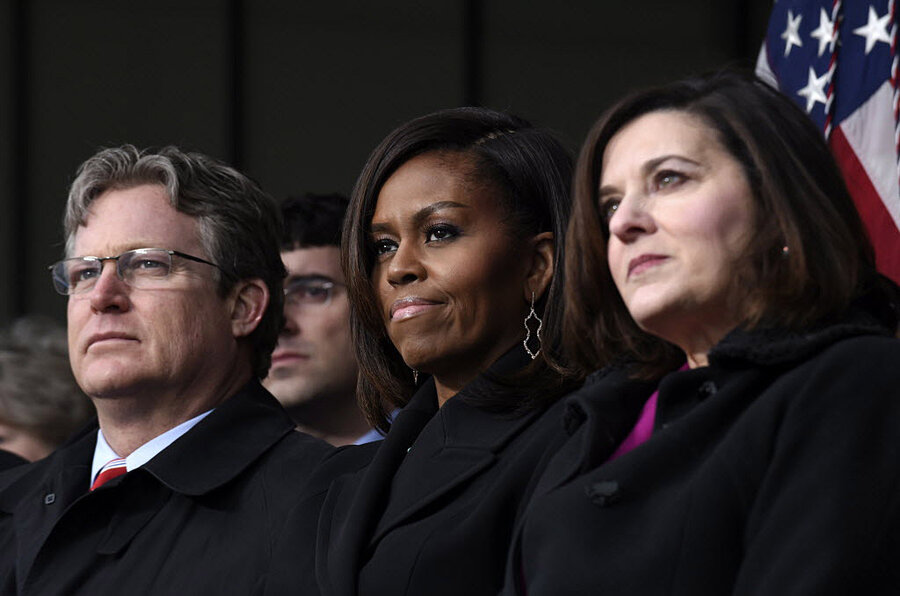Will new Senate institute honoring Ted Kennedy foster bipartisan cooperation?
Loading...
Some of the nation's most prominent political leaders gathered in Boston, Monday, in hopes of reviving the bipartisan spirit of the late Sen. Edward Kennedy.
President Obama and top members of his Democratic administration were joined by Republicans Sen. John McCain of Arizona and former Senate majority leader Trent Lott for the dedication of the Edward M. Kennedy Institute for the United States Senate.
The facility, which includes a full-scale replica of the Senate chamber, interactive software to replicate the lawmaking process for high-school and middle-school students, and exhibitions that spectators can interact with through a tablet, has been touted as a way to re-inspire faith in the Senate.
Currently, the Senate’s approval rating hangs around 18 percent, and bipartisan dealmaking, one of Senator Kennedy’s hallmark attributes, is elusive. Now, the center aims to rebuild the Senate’s reputation by rekindling the spirit of cooperation and bipartisan lawmaking that Kennedy was so skilled at cultivating.
“The real contribution of the institute will be from the bottom up as an educational tool. It can be used to teach future lawmakers about the benefits of bipartisan cooperation,” says Sarah Binder, senior fellow of the Brookings Institute.
Kennedy conceived the idea before he was diagnosed with cancer in 2008.
“He saw the breakdown in Congress. And he was one of the few who could really work across the aisles," says Mickey Edwards, a former Republican congressman from Oklahoma, in a phone interview. "I think he would be disappointed today. He got there [to the Senate] in the '60s, and every major issue that came up was worked at in a bipartisan way, and that was really serious stuff, Medicare stuff. But he really believed that the Senate was the world’s greatest deliberative body.”
Kennedy, who believed in the majesty of the Senate, wanted the center to be a place where people would learn what it was like to really work inside the chamber, family members told The New York Times.
The facility’s main focus is to teach young students about the realities of lawmaking through the “Senate immersion model,” which allows students to be sworn in as senators, attend mock hearings, write legislation, propose amendments, and debate on the Senate floor the way Kennedy loved to do.
“They learn how difficult it is to pass legislation,” explained Kennedy’s widow, Victoria Kennedy, who serves as president of the institute’s board of directors, according to a local NPR affiliate. “Our founders planned it that way. So you have a different look at Washington. You say, ‘Well, it really was intended to be difficult.’ ”
Despite his reputation as one of the most liberal members of the Senate, Kennedy found ways to create landmark legislation with Republicans on tricky topics such as immigration, health care, and education, experts say.
“What Kennedy was known for is certainly absent today. He was a stalwart of the left, but his Senate career was remarkable because he was willing to work across the aisle, he was able to craft these larger deals. There was an element of trust across party lines," says Ms. Binder. "These types of dynamics have been very hard to find in recent years. Often the two parties aren’t even willing to sit down together.”
Now, staff at the center say they hope the simulation experience will serve as an opportunity for students to learn how to tolerate opposing views and cooperate.
Even the institute's dedication, which was attended by Democratic and Republic lawmakers alike, managed to facilitate an atmosphere of bipartisan camaraderie.
“Yes, a Republican from Mississippi is proud to be here today,” joked Mr. Lott, who is also on the institute's board of directors.
And Republican Senator McCain also highlighted Kennedy’s ability to work across party lines.
"I miss fighting with him to be honest. It's gotten harder to find people who enjoy a good fight as much as Ted did," Senator McCain said at the event Monday.
But if the center is really going to boost civic awareness and inspire a love of governance, Mr. Edwards says it is important that educators take full advantage of its facilities and do not solely treat it as a way to remember Kennedy.
“It [the center] is in a very political area with very good schools. If you have a lot of high school teachers taking their schools there, it could really be worth it. But I think it’s important for the people who run it to take it seriously and not only turn it into a shrine," says Edwards.
At Monday’s event, Obama said it was appropriate for Kennedy to want "a monument not to himself but to what we the people have the power to do together."
"What if we carried ourselves more like Ted Kennedy?” he asked.
The institute, which costs $79 million, sits next to the presidential library of Kennedy’s brother, John F. Kennedy.








